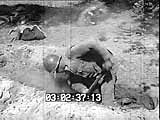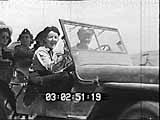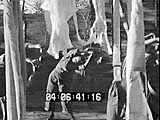|
Men are almost always active in the newsreels. Male soldiers are engaged in battle, training or setting up equipment. There are almost no instances where nurses are working. During the "Allied Invasion of Salerno" the men are involved in "constant action and dog fighting" and the "terrifying spectacle and pandemonium of war."

Men are almost always active in the newsreels. |

In comparison, nurses arrive in a chauffeured jeep, smiling and wearing pristine white clothing.
|
The nurses or "Angels of Mercy", in comparison, arrive in a chauffeured jeep, smiling and wearing pristine white clothing. They appear in no particular hurry (see Fox Movietonenews, "War News: Allied Invasion of Salerno," September 27, 1943, 50-252 V. 26/8). At a time when there is an immediate need for nurses, the newsreels make the nurses appear undedicated, a giggly untrained lot. The seriousness of their task is missing as we see exotic images of attractively dressed nurses making their way to a new hospital "like traditional tourists riding camels" (see Fox Movietonenews, "New Flashes of the War: Red Cross Sightseers," September 27, 1943, 50-252 V. 26/9).
Women's work is also negated and disqualified in newsreels that emphasize nurses in training. The voice-over commentary suggests their hard exercises are mere play or, at the very least a slight distraction from their vacation. One scene is shot through a clothesline full of women's undergarments and the female narrator comments that "women train in a sea of laundry" (see Fox Movietonenews, "Women in the News: Army Nurses in Training," April 1944, 51-590 V. 26/66). Images that might diverge from traditional femininity were juxtaposed and undermined by representations of female silliness, and weakness in will power, to reinforce societal gender norms.

Nurses make their way to a new hospital "like traditional tourists riding camels." |

Nurses exercise while the camera prowls through a clothesline full of women's undergarments.
|
The respect men had for their fellow soldiers did not extend to the nurses. If respect was gained, it was qualified with some belittling remark regarding sex and gender. This served to separate, subordinate and contain nurses from a male space. Five Army Air Force nurses were presented with the coveted air medal and oak leaf clusters in honor of their heroic exploits. The medals were presented by Major Hubert Harmon and he said,
I want you to know that in the hearts of the 13th Air Force, you are not only lovely ladies, but real comrades. Comrades who have shared our dangers and privations, comrades who have flown longer, worked harder and complained less than we ourselves, comrades who have eased the pain and suffering of many a sick or wounded soldier in this theater. In bidding you good-bye, I express the sentiments of the entire command when I say God-bless and we love you all. (Fox Movietonenews, "Army Air Force Nurses," March 1944, 51-475 V. 26/60.)
Harmon sends a clear message that these women are still "typical women." He essentializes them, praising their "innate" skills including femininity, caring and nurturing. Harmon makes an effort to point out the nurses' excellent service in the line of duty but implies that it was not originally expected of them. Indeed, the nurses had crossed a gender boundary when they outperformed the expectations the armed services envisioned for them. This masculinizing performance by the women was undermined by a feminizing farewell by Harmon, expressing love and concern for the women.
page 1 of 2

|








